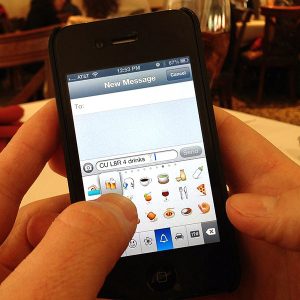
(RNS) — In addition to smiley faces, high heels and frogs, Unicode is rolling out a new batch of 250 emojis, among them a set of religious icons.
Unicode is the character coding system that gives a unique number for every character, allowing different companies to have access and the support for universal emojis.
The new emojis will feature three types of crosses, the dove of peace and the Om symbol, a mystical Sanskrit sound of Hindu origin. They will join an emoji cast that includes an angel and a devil.
RELATED RESOURCES:
- A blind Hindu, an elephant — and a social media policy?
- Social media commandments
- Social Media Risk Management: A Starter Kit

The new emojis will be available with the Unicode 7.0 update. But that doesn’t mean users will have them right away. Companies such as Apple, Microsoft and Google have to decide which emojis they want and how they’ll look before customers have the option to use them.
Apple, Microsoft and Google declined to comment on whether they plan to use any of the religious emojis.
Rick McGowan, technical vice president of Unicode, said symbols are added “because they are in general, widespread use as text symbols in one context or another.”
McGowan also said symbols are added after they are proposed by Unicode members or by the general public through an online proposal form.
But with the lack of religious emojis before this announcement, other apps have been vying to fill growing need.
Michelle Sullivan and Ana Streczyn founded GodsMAC Apps in 2012 and released the apps Holy Emojis, Pic Christian and Pic Christian Pro.
While parts of Holy Emojis and Pic Christian are free, Pic Christian Pro sells for $2. The description says that Pic Christian Pro combines the first two apps, including picture collages and emojis, and uses the slogan “With Pic Christian, you are God’s Messenger.”
The Holy Emojis app was the first to give Christians more than 100 emojis, including a symbol of a Jesus fish or cross.
“I think instead of writing a quote from the Bible or a quote from a prayer book or whatever, they can just send a picture,” Sullivan said. “And a picture speaks a thousand words.”
Sullivan also began noticing that people often use text as their main mode of communication. The texts, however, aren’t long paragraphs; people try to use as few words as possible. Emojis make that easier.
“So if you can send a picture and just say, ‘Hey, thanks for the wonderful night last night,’ with an emoji or a cross or any kind of emoji, it’s like you immediately understand what that person is trying to say,” Sullivan said.
To access Sullivan’s emojis, people have to open another application, unlike Unicode’s emojis, which are embedded into the operating system. But she said that doesn’t stop people from using them.
GodsMAC Apps plans to expand its apps and emoji selection to the Android format by December. Then the company plans to broaden its religious emojis to include ones specific to the Catholic, Jewish and Islamic faiths.
Religious emojis are extremely limited for now, but there is a free option for Jews called Emojew that has Passover-related emojis.


